Alfa Romeo MiTo 2020 Owner handbook (in English)
Manufacturer: ALFA ROMEO, Model Year: 2020, Model line: MiTo, Model: Alfa Romeo MiTo 2020Pages: 212, PDF Size: 5.18 MB
Page 91 of 212
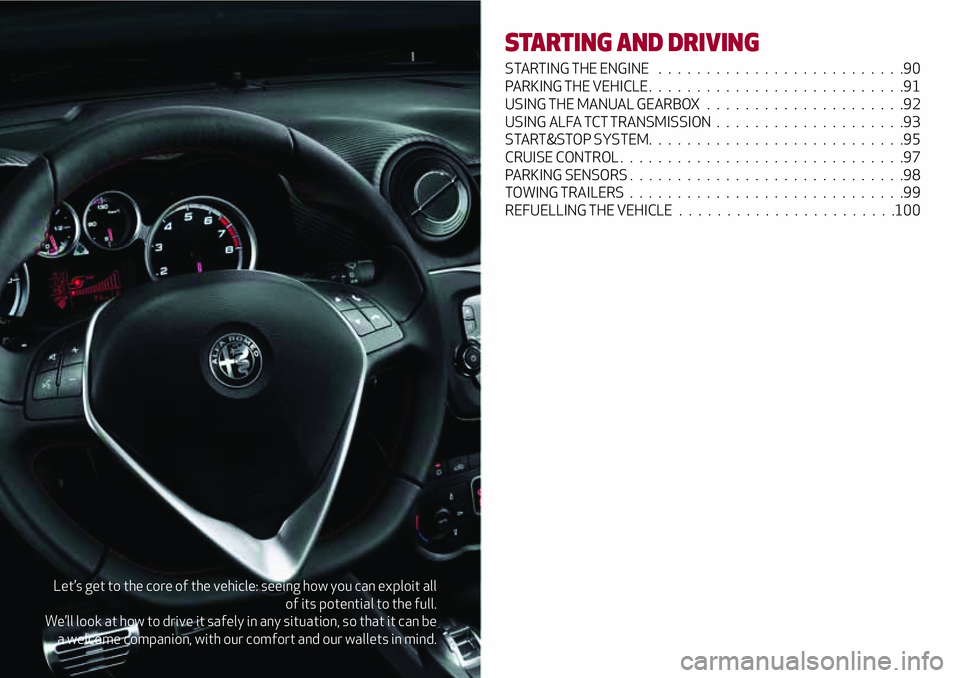
Let’s get to the core of the vehicle: seeing how you can exploit all
of its potential to the full.
We’ll look at how to drive it safely in any situation, so that it can be
a welcome companion, with our comfort and our wallets in mind.
STARTING AND DRIVING
STARTING THE ENGINE . .........................90
PARKING THE VEHICLE ...........................91
USING THE MANUAL GEARBOX .....................92
USING ALFA TCT TRANSMISSION . . . . ................93
START&STOP SYSTEM. ..........................95
CRUISE CONTROL ..............................97
PARKING SENSORS .............................98
TOWING TRAILERS . . . . . . . . .....................99
REFUELLING THE VEHICLE . . .....................100
Page 92 of 212
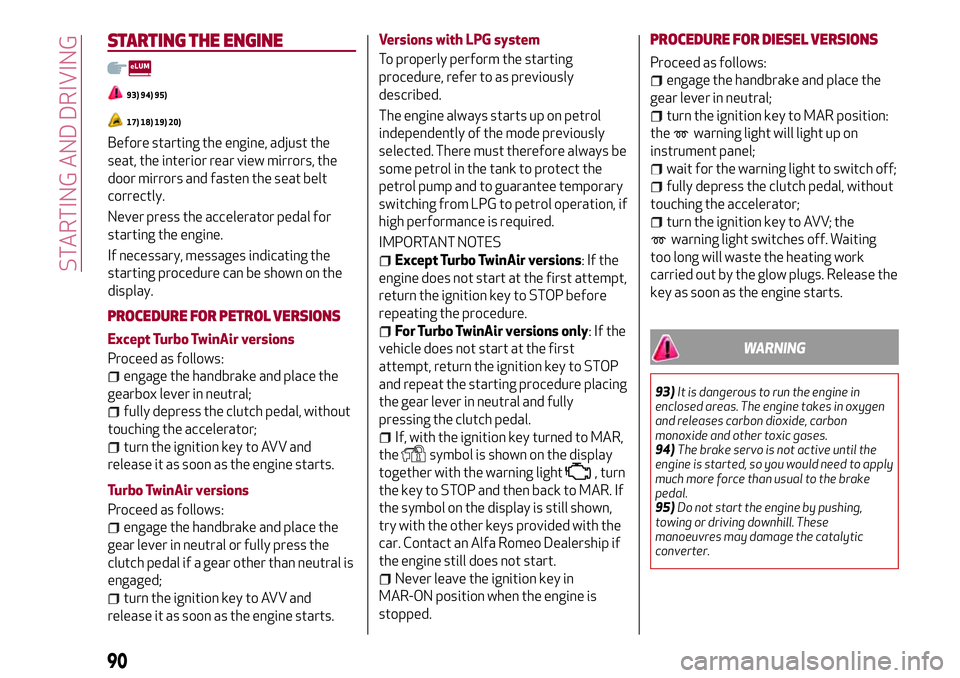
STARTING THE ENGINE
93) 94) 95)
17) 18) 19) 20)
Before starting the engine, adjust the
seat, the interior rear view mirrors, the
door mirrors and fasten the seat belt
correctly.
Never press the accelerator pedal for
starting the engine.
If necessary, messages indicating the
starting procedure can be shown on the
display.
PROCEDURE FOR PETROL VERSIONS
Except Turbo TwinAir versions
Proceed as follows:
engage the handbrake and place the
gearbox lever in neutral;
fully depress the clutch pedal, without
touching the accelerator;
turn the ignition key to AVV and
release it as soon as the engine starts.
Turbo TwinAir versions
Proceed as follows:
engage the handbrake and place the
gear lever in neutral or fully press the
clutch pedal if a gear other than neutral is
engaged;
turn the ignition key to AVV and
release it as soon as the engine starts.Versions with LPG system
To properly perform the starting
procedure, refer to as previously
described.
The engine always starts up on petrol
independently of the mode previously
selected. There must therefore always be
some petrol in the tank to protect the
petrol pump and to guarantee temporary
switching from LPG to petrol operation, if
high performance is required.
IMPORTANT NOTES
Except Turbo TwinAir versions:Ifthe
engine does not start at the first attempt,
return the ignition key to STOP before
repeating the procedure.
For Turbo TwinAir versions only:Ifthe
vehicle does not start at the first
attempt, return the ignition key to STOP
and repeat the starting procedure placing
the gear lever in neutral and fully
pressing the clutch pedal.
If, with the ignition key turned to MAR,
the
symbol is shown on the display
together with the warning light
, turn
the key to STOP and then back to MAR. If
the symbol on the display is still shown,
try with the other keys provided with the
car. Contact an Alfa Romeo Dealership if
the engine still does not start.
Never leave the ignition key in
MAR-ON position when the engine is
stopped.
PROCEDURE FOR DIESEL VERSIONS
Proceed as follows:
engage the handbrake and place the
gear lever in neutral;
turn the ignition key to MAR position:
the
warning light will light up on
instrument panel;
wait for the warning light to switch off;
fully depress the clutch pedal, without
touching the accelerator;
turn the ignition key to AVV; the
warning light switches off. Waiting
too long will waste the heating work
carried out by the glow plugs. Release the
key as soon as the engine starts.
WARNING
93)It is dangerous to run the engine in
enclosed areas. The engine takes in oxygen
and releases carbon dioxide, carbon
monoxide and other toxic gases.
94)The brake servo is not active until the
engine is started, so you would need to apply
much more force than usual to the brake
pedal.
95)Do not start the engine by pushing,
towing or driving downhill. These
manoeuvres may damage the catalytic
converter.
90
STARTING AND DRIVING
Page 93 of 212
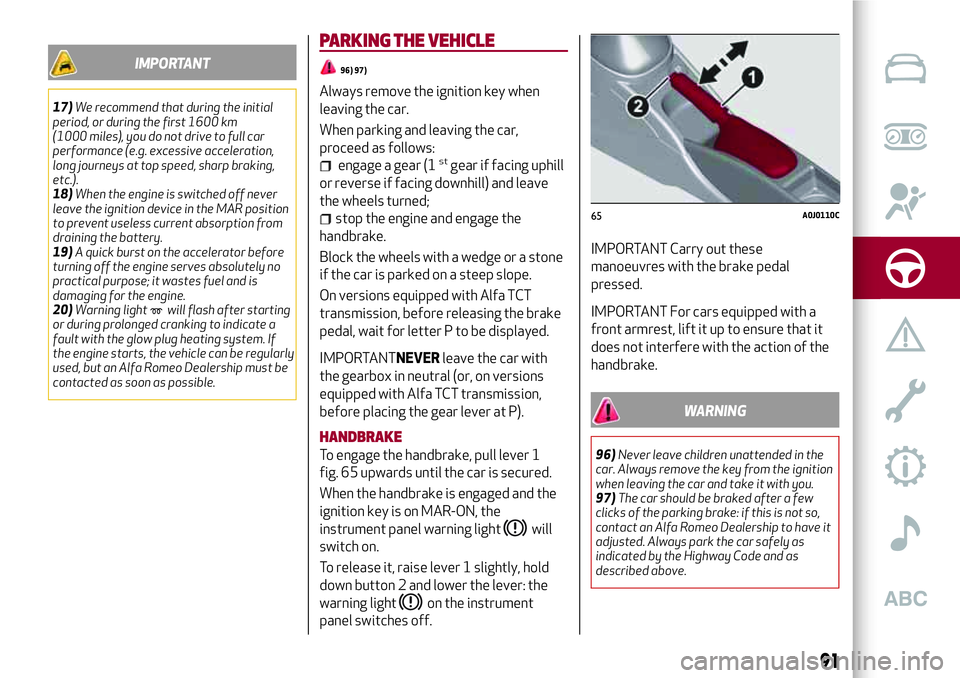
IMPORTANT
17)We recommend that during the initial
period, or during the first 1600 km
(1000 miles), you do not drive to full car
performance (e.g. excessive acceleration,
long journeys at top speed, sharp braking,
etc.).
18)When the engine is switched off never
leave the ignition device in the MAR position
to prevent useless current absorption from
draining the battery.
19)A quick burst on the accelerator before
turning off the engine serves absolutely no
practical purpose; it wastes fuel and is
damaging for the engine.
20)Warning light
will flash after starting
or during prolonged cranking to indicate a
fault with the glow plug heating system. If
the engine starts, the vehicle can be regularly
used, but an Alfa Romeo Dealership must be
contacted as soon as possible.
PARKING THE VEHICLE
96) 97)
Always remove the ignition key when
leaving the car.
When parking and leaving the car,
proceed as follows:
engage a gear (1stgear if facing uphill
or reverse if facing downhill) and leave
the wheels turned;
stop the engine and engage the
handbrake.
Block the wheels with a wedge or a stone
if the car is parked on a steep slope.
On versions equipped with Alfa TCT
transmission, before releasing the brake
pedal, wait for letter P to be displayed.
IMPORTANTNEVERleave the car with
the gearbox in neutral (or, on versions
equipped with Alfa TCT transmission,
before placing the gear lever at P).
HANDBRAKE
To engage the handbrake, pull lever 1
fig. 65 upwards until the car is secured.
When the handbrake is engaged and the
ignition key is on MAR-ON, the
instrument panel warning light
will
switch on.
To release it, raise lever 1 slightly, hold
down button 2 and lower the lever: the
warning light
on the instrument
panel switches off.
IMPORTANT Carry out these
manoeuvres with the brake pedal
pressed.
IMPORTANT For cars equipped with a
front armrest, lift it up to ensure that it
does not interfere with the action of the
handbrake.
WARNING
96)Never leave children unattended in the
car. Always remove the key from the ignition
when leaving the car and take it with you.
97)The car should be braked after a few
clicks of the parking brake: if this is not so,
contact an Alfa Romeo Dealership to have it
adjusted. Always park the car safely as
indicated by the Highway Code and as
described above.
65A0J0110C
91
Page 94 of 212
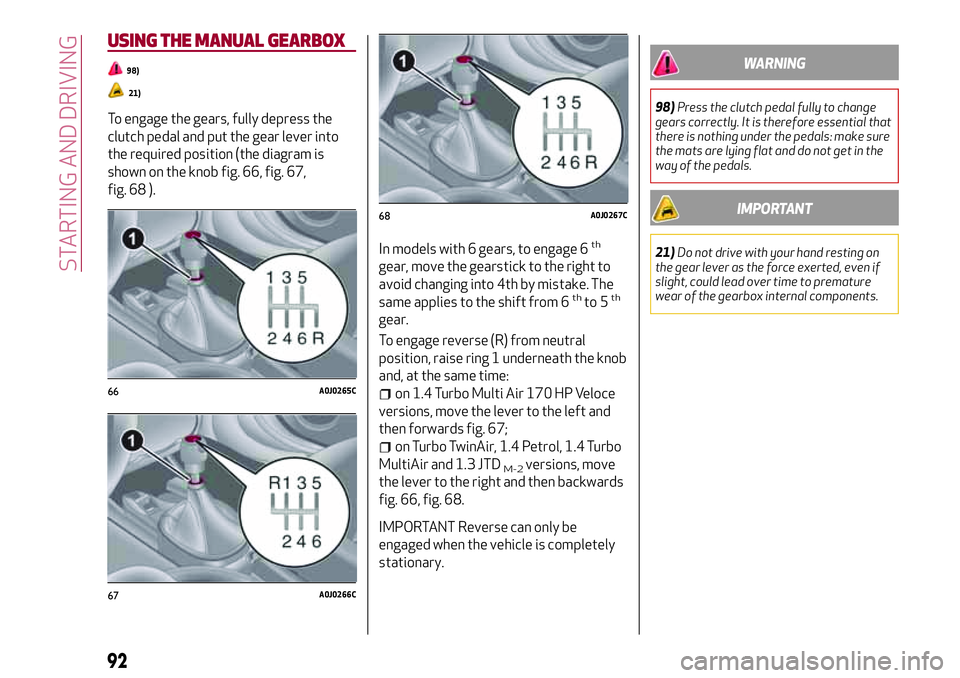
USING THE MANUAL GEARBOX
98)
21)
To engage the gears, fully depress the
clutch pedal and put the gear lever into
the required position (the diagram is
shown on the knob fig. 66, fig. 67,
fig. 68 ).
In models with 6 gears, to engage 6
th
gear, move the gearstick to the right to
avoid changing into 4th by mistake. The
same applies to the shift from 6
thto 5th
gear.
To engage reverse (R) from neutral
position, raise ring 1 underneath the knob
and, at the same time:
on 1.4 Turbo Multi Air 170 HP Veloce
versions, move the lever to the left and
then forwards fig. 67;
on Turbo TwinAir, 1.4 Petrol, 1.4 Turbo
MultiAir and 1.3 JTD
M-2versions, move
the lever to the right and then backwards
fig. 66, fig. 68.
IMPORTANT Reverse can only be
engaged when the vehicle is completely
stationary.
WARNING
98)Press the clutch pedal fully to change
gears correctly. It is therefore essential that
there is nothing under the pedals: make sure
the mats are lying flat and do not get in the
way of the pedals.
IMPORTANT
21)Do not drive with your hand resting on
the gear lever as the force exerted, even if
slight, could lead over time to premature
wear of the gearbox internal components.
66A0J0265C
67A0J0266C
68A0J0267C
92
STARTING AND DRIVING
Page 95 of 212
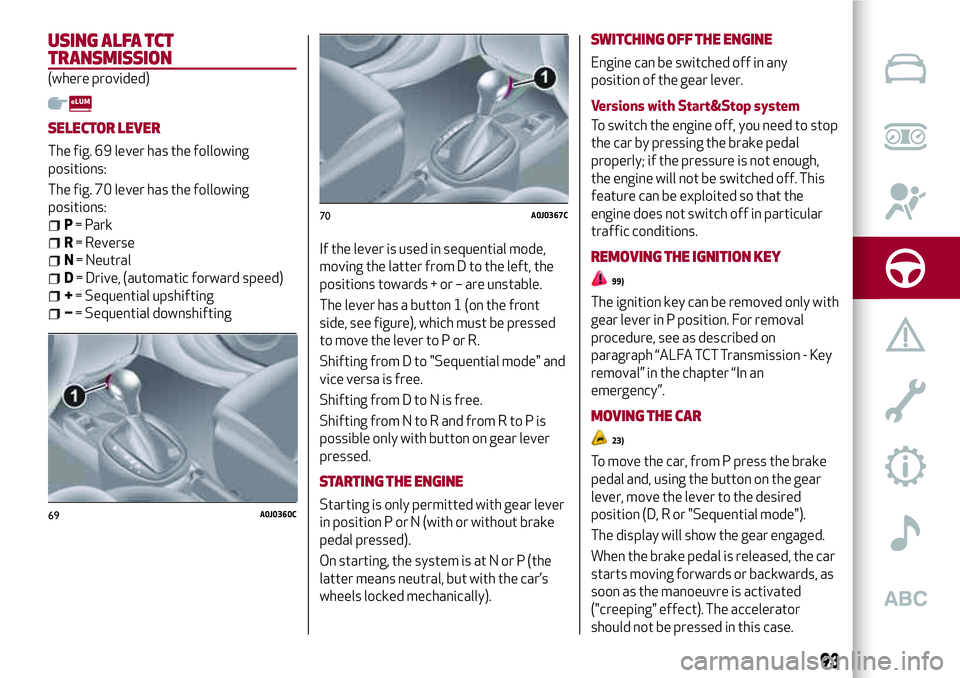
USING ALFA TCT
TRANSMISSION
(where provided)
SELECTOR LEVER
The fig. 69 lever has the following
positions:
The fig. 70 lever has the following
positions:
P= Park
R= Reverse
N= Neutral
D= Drive, (automatic forward speed)
+= Sequential upshifting
−= Sequential downshiftingIf the lever is used in sequential mode,
moving the latter from D to the left, the
positions towards + or – are unstable.
The lever has a button 1 (on the front
side, see figure), which must be pressed
to move the lever to P or R.
Shifting from D to "Sequential mode" and
vice versa is free.
Shifting from D to N is free.
Shifting from N to R and from R to P is
possible only with button on gear lever
pressed.
STARTING THE ENGINE
Starting is only permitted with gear lever
in position P or N (with or without brake
pedal pressed).
On starting, the system is at N or P (the
latter means neutral, but with the car’s
wheels locked mechanically).
SWITCHING OFF THE ENGINE
Engine can be switched off in any
position of the gear lever.
Versions with Start&Stop system
To switch the engine off, you need to stop
the car by pressing the brake pedal
properly; if the pressure is not enough,
the engine will not be switched off. This
feature can be exploited so that the
engine does not switch off in particular
traffic conditions.
REMOVING THE IGNITION KEY
99)
The ignition key can be removed only with
gear lever in P position. For removal
procedure, see as described on
paragraph “ALFA TCT Transmission - Key
removal” in the chapter “In an
emergency”.
MOVING THE CAR
23)
To move the car, from P press the brake
pedal and, using the button on the gear
lever, move the lever to the desired
position (D, R or "Sequential mode").
The display will show the gear engaged.
When the brake pedal is released, the car
starts moving forwards or backwards, as
soon as the manoeuvre is activated
("creeping" effect). The accelerator
should not be pressed in this case.
69A0J0360C
70A0J0367C
93
Page 96 of 212
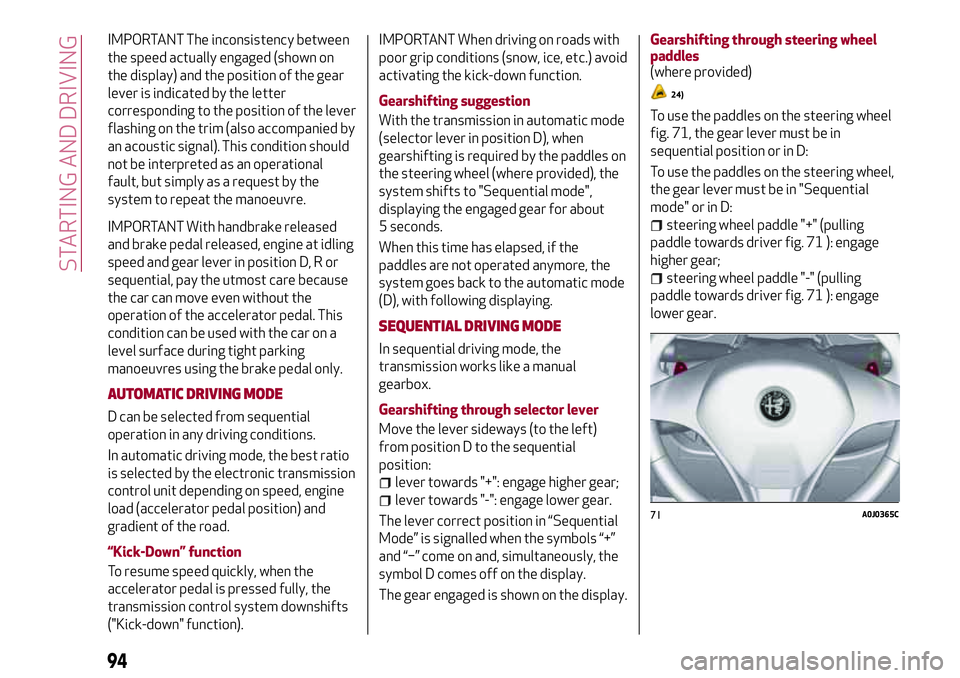
IMPORTANT The inconsistency between
the speed actually engaged (shown on
the display) and the position of the gear
lever is indicated by the letter
corresponding to the position of the lever
flashing on the trim (also accompanied by
an acoustic signal). This condition should
not be interpreted as an operational
fault, but simply as a request by the
system to repeat the manoeuvre.
IMPORTANT With handbrake released
and brake pedal released, engine at idling
speed and gear lever in position D, R or
sequential, pay the utmost care because
the car can move even without the
operation of the accelerator pedal. This
condition can be used with the car on a
level surface during tight parking
manoeuvres using the brake pedal only.
AUTOMATIC DRIVING MODE
D can be selected from sequential
operation in any driving conditions.
In automatic driving mode, the best ratio
is selected by the electronic transmission
control unit depending on speed, engine
load (accelerator pedal position) and
gradient of the road.
“Kick-Down” function
To resume speed quickly, when the
accelerator pedal is pressed fully, the
transmission control system downshifts
("Kick-down" function).
IMPORTANT When driving on roads with
poor grip conditions (snow, ice, etc.) avoid
activating the kick-down function.
Gearshifting suggestion
With the transmission in automatic mode
(selector lever in position D), when
gearshifting is required by the paddles on
the steering wheel (where provided), the
system shifts to "Sequential mode",
displaying the engaged gear for about
5 seconds.
When this time has elapsed, if the
paddles are not operated anymore, the
system goes back to the automatic mode
(D), with following displaying.
SEQUENTIAL DRIVING MODE
In sequential driving mode, the
transmission works like a manual
gearbox.
Gearshifting through selector lever
Move the lever sideways (to the left)
from position D to the sequential
position:
lever towards "+": engage higher gear;
lever towards "-": engage lower gear.
The lever correct position in “Sequential
Mode” is signalled when the symbols “+”
and “−” come on and, simultaneously, the
symbol D comes off on the display.
The gear engaged is shown on the display.Gearshifting through steering wheel
paddles
(where provided)
24)
To use the paddles on the steering wheel
fig. 71, the gear lever must be in
sequential position or in D:
To use the paddles on the steering wheel,
the gear lever must be in "Sequential
mode" or in D:
steering wheel paddle "+" (pulling
paddle towards driver fig. 71 ): engage
higher gear;
steering wheel paddle "-" (pulling
paddle towards driver fig. 71 ): engage
lower gear.
71A0J0365C
94
STARTING AND DRIVING
Page 97 of 212
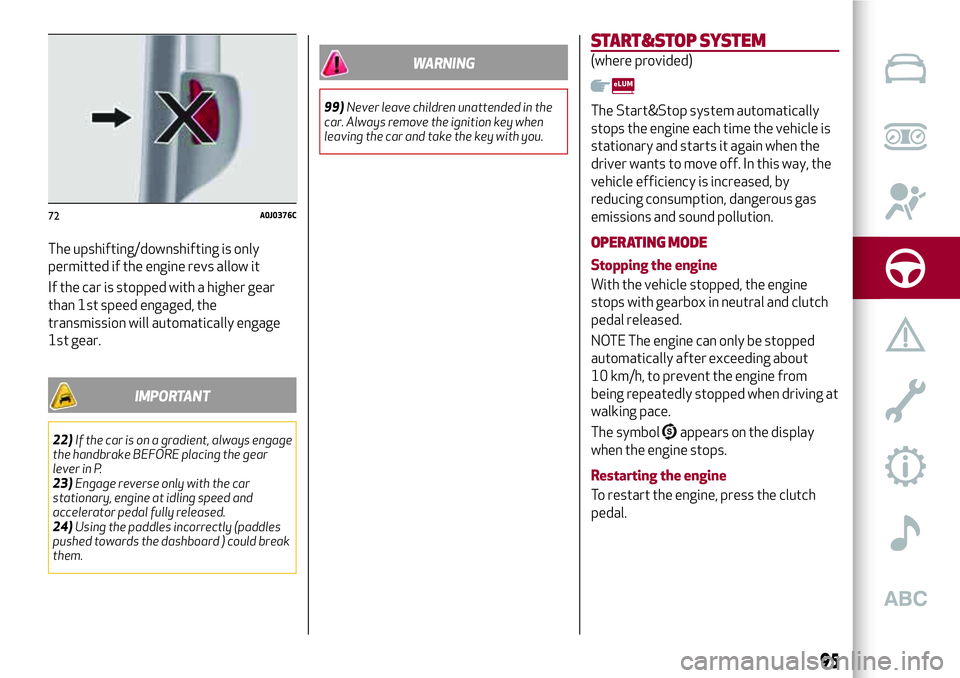
The upshifting/downshifting is only
permitted if the engine revs allow it
If the car is stopped with a higher gear
than 1st speed engaged, the
transmission will automatically engage
1st gear.
IMPORTANT
22)If the car is on a gradient, always engage
the handbrake BEFORE placing the gear
lever in P.
23)Engage reverse only with the car
stationary, engine at idling speed and
accelerator pedal fully released.
24)Using the paddles incorrectly (paddles
pushed towards the dashboard ) could break
them.
WARNING
99)Never leave children unattended in the
car. Always remove the ignition key when
leaving the car and take the key with you.
START&STOP SYSTEM
(where provided)
The Start&Stop system automatically
stops the engine each time the vehicle is
stationary and starts it again when the
driver wants to move off. In this way, the
vehicle efficiency is increased, by
reducing consumption, dangerous gas
emissions and sound pollution.
OPERATING MODE
Stopping the engine
With the vehicle stopped, the engine
stops with gearbox in neutral and clutch
pedal released.
NOTE The engine can only be stopped
automatically after exceeding about
10 km/h, to prevent the engine from
being repeatedly stopped when driving at
walking pace.
The symbol
appears on the display
when the engine stops.
Restarting the engine
To restart the engine, press the clutch
pedal.
72A0J0376C
95
Page 98 of 212

SYSTEM MANUAL ACTIVATION /
DEACTIVATION
To activate/deactivate manually the
system, press the fig. 73 button on the
trim next to the steering wheel.
Start&Stop system activation:A
message will appear on the display when
the Start&Stop system is activated.
Start&Stop system deactivation: The
symbol and a message will appear on
the display. When the system is
deactivated, the
warning light on the
instrument panel switches on.
MISSED ENGINE STOPPING
CONDITIONS
25)
When the system is active, for a higher
comfort and safety, and to reduce
emissions, the engine does not stop in
certain ambient conditions, engineconditions, with the driver door not
closed and driver seat belt unfastened.
SAFETY FUNCTIONS
When the engine is stopped by the
Start&Stop system, if the driver releases
his/her seat belt and opens the driver's or
passenger's door, the engine can be
restarted only by the ignition key.
The driver is informed by a buzzer and by
the flashing of the symbol
on the
display (on some versions, a message is
displayed as well).
"ENERGY SAVING" FUNCTION(where provided)
If, following the automatic engine
restarting, the driver does not carry out
any action on the vehicle for over
3 minutes, the Start&Stop system stops
the engine definitely, to prevent fuel
consumption. In these cases, the engine
can be restarted only using the ignition
key.
NOTE In any case, it is possible to keep
the engine running by deactivating the
Start&Stop system.
IRREGULAR OPERATION
In the event of malfunction, the
Start&Stop system is deactivated.
The fault is indicated by the
symbol
switching on (on some version a specific
message is also shown) on the display.In this case, contact an Alfa Romeo
Dealership.
VEHICLE INACTIVITY
100)
In the event of vehicle inactivity (or if the
battery is replaced), special attention
must be paid to the disconnection of the
battery power supply.
IMPORTANT After turning the ignition
key to STOP, wait at least 1 minute
before disconnecting the electrical
supply to the battery.
IMPORTANT
25)If climate comfort is to be favoured, the
Stop/Start system can be deactivated, for a
continuous operation of the climate control
system.
WARNING
100)When replacing the battery, always
contact an Alfa Romeo Dealership. Replace
the battery with one of the same type
(HEAVY DUTY) and with the same
specifications.
73A0J0307C
96
STARTING AND DRIVING
Page 99 of 212

CRUISE CONTROL
(where provided)
DESCRIPTION
This is an electronic driving aid that
allows you to drive at a speed of above
30 km/h on long and straight dry roads
(e.g. motorways), at a preset speed
without having to press the accelerator
pedal. It is therefore not recommended
to use this device on extra-urban roads
with traffic. Do not use it in town.
ACTIVATING THE DEVICE
101) 102)
Turn ring 1 fig. 74 to ON.
The device cannot be engaged in 1stor
reverse gear: it is advisable to engage it
in 5
thgear or higher.When travelling downhill with the device
engaged, the car may slightly exceed the
stored speed.
Activation is indicated by the
warning
light switching on and, on some versions,
by a message on the display.
SETTING THE DESIRED SPEED
Proceed as follows:
turn ring 1 fig. 74 to ON and press the
accelerator to reach the required speed;
move the stalk upwards (+) for at least
1 second, then release it: the car speed is
now stored and you can therefore release
the accelerator.
If needed (when overtaking for instance),
you can accelerate simply by pressing the
accelerator; when you release the pedal,
the vehicle goes back to the speed stored
previously.
RESTORING THE MEMORISED SPEED
If the device has been disengaged by
pressing the brake or clutch pedal, the
stored speed can be reset as follows:
accelerate gradually until a speed
approaching the one stored is reached;
engage the gear selected at the time
that the speed was stored;
press the RES 2 fig. 74 button.
INCREASING THE MEMORISED SPEED
Press the accelerator and store the new
speed or move the stalk upwards (+).
REDUCING THE MEMORISED SPEED
Deactivate the device and store the new
speed or move the lever upwards (–) until
the new speed is reached. It will then
automatically be memorised.
DEACTIVATING THE DEVICE
To turn the device off:
Turn the ring 1 fig. 74 to the OFF
position;
or
switch off the engine;
or
press the brake pedal, the clutch or the
accelerator; in this last case the system is
not effectively deactivated but the
system gives priority to the acceleration
request. The device still remains active,
without the need to press the RES button
to return to the previous conditions once
acceleration is concluded.
Automatic deactivation
The device is automatically switched off
in the following cases:
if the ABS or ESC systems intervene;
with the vehicle speed below the set
limit;
in the event of system failure.
74A0J0065C
97
Page 100 of 212

WARNING
101)When travelling with the device active,
never move the gear lever to neutral.
102)In case of a malfunction or failure of
the device, contact an Alfa Romeo
Dealership.
PARKING SENSORS
(where provided)
103) 104)
26)
The sensors are located in the vehicle
rear bumper fig. 75 and their function is
to inform the driver, through an
intermittent acoustic and visual signal,
about the presence of obstacles behind
the vehicle.
ACTIVATION/DEACTIVATION
The sensors are turned on when reverse
gear is engaged. As the distance from the
obstacle behind the vehicle decreases,
the frequency of the acoustic signal
increases.
When the reverse gear is disengaged, the
sensors deactivate.
ACOUSTIC SIGNAL
When reverse gear is engaged an
acoustic signal is automatically activated
if there is an obstacle within the range of
operation.
The acoustic signal:
increases as the distance between the
vehicle and the obstacle decreases;
becomes continuous when the
distance between the car and the
obstacle is less than 30 cm and stops
immediately if the distance increases;
remains constant if the distance
remains unchanged; if this situation
concerns the side sensors, the buzzer will
stop after about 3 seconds to avoid, for
example, warning indications in the event
of manoeuvres along walls.
OPERATION WITH A TRAILER
Parking sensor operation is automatically
turned off when the trailer electric cable
plug is fitted into the car tow hook
socket.
IMPORTANT NOTES
During parking manoeuvres, pay the
utmost attention to any obstacles that
could be located above or below the
sensors.
Objects set close to the car rear, under
certain circumstances are not detected
and could therefore cause damage to the
car or be damaged.
75A0J0088C
98
STARTING AND DRIVING